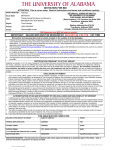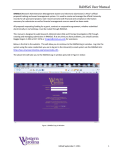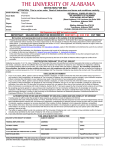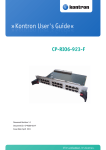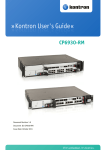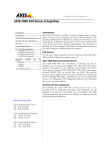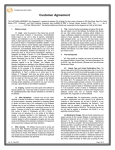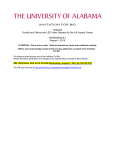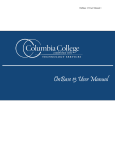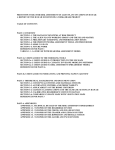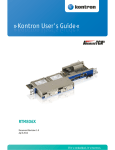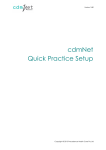Download Medication order communication using fax and document
Transcript
Medication-Use technology Medication order communication m e d i c at i o n - u s e t e c h n o l o g y Medication order communication using fax and document-imaging technologies S Armen I. Simonian harp HealthCare is an integrated regional health care delivery system based in San Diego, California. Sharp’s Institutional Care Division includes four acute care hospitals and three specialty hospitals with a total of 1851 licensed beds. Sharp recently began the implementation of a new electronic medical record (EMR) system, which includes computerized prescriber-order-entry (CPOE), and expects to complete this initiative at the seven affiliated hospitals by the end of 2009. Until CPOE is fully implemented, clinicians must continue with current procedures to transfer paper-chart orders from nursing stations to centralized and decentralized pharmacy orderprocessing locations. Traditionally, these procedures have entailed a combination of pharmacy “runners” rounding periodically to retrieve orders and nursing personnel handcarrying orders to the pharmacy, sending orders via pneumatic tube systems, or faxing orders that print out in the pharmacy. Problems with these procedures include delays in hand delivery, lost tubes, incorrectly addressed tubes, unavailability of tubes, unsuccessful faxes, fax printer Purpose. The implementation of fax and document-imaging technology to electronically communicate medication orders from nursing stations to the pharmacy is described. Methods. The evaluation of a commercially available pharmacy order imaging system to improve order communication and to make document retrieval more efficient led to the selection and customization of a system already licensed and used in seven affiliated hospitals. The system consisted of existing fax machines and documentimaging software that would capture images of written orders and send them from nursing stations to a central database server. Pharmacists would then retrieve the images and enter the orders in an electronic medical record system. The pharmacy representatives from all seven hospitals agreed on the configuration and functionality of the custom application. Results. A 30-day trial of the order imaging system was successfully conducted jams, and poor-quality or illegible faxes. A review of the literature revealed two articles describing similar issues with paper-order handling; both institutions reported the use of scanning technology to address these issues.1,2 Armen I. Simonian, Pharm.D., is Pharmacy Information Specialist, Sharp HealthCare, 8965 Spectrum Center Boulevard, San Diego, CA 92123. Melissa E. Lopez, Senior Systems Analyst, and Cathy Fuhrman, Manager, Document Imaging Group, Sharp Information Systems Department, are acknowledged for their original development of the 570 Am J Health-Syst Pharm—Vol 65 Mar 15, 2008 at one of the larger institutions. The new system was then implemented at the remaining six hospitals over a period of 60 days. The transition from a paper-order system to electronic communication via a standardized pharmacy document management application tailored to the specific needs of this health system was accomplished. Conclusion. A health system with seven affiliated hospitals successfully implemented electronic communication and the management of inpatient paper-chart orders by using faxes and document-imaging technology. This standardized application eliminated the problems associated with the hand delivery of paper orders, the use of the pneumatic tube system, and the printing of traditional faxes. Index terms: Computers; Medication orders; Pharmacy, institutional, hospital; Technology Am J Health-Syst Pharm. 2008; 65:570-3 Development of electronic communication for medication orders To improve order communication, we investigated electronic order communication methods to replace the traditional written orders. Sharp concept and their significant work on the programming and documentation of the software. Copyright © 2008, American Society of Health-System Pharmacists, Inc. All rights reserved. 1079-2082/08/0302-0570$06.00. DOI 10.2146/ajhp070461 Medication-Use technology Medication order communication HealthCare uses automated dispensing cabinets supplied by Pyxis (Cardinal Health, Dublin, OH), and therefore we decided to evaluate the company’s companion product, Pyxis Connect. This product captures images of written orders via dedicated scanning devices placed at nursing stations. The images are sent to a central database server. Pharmacists retrieve the order images on dedicated computer screens in the pharmacy and perform order entry in the EMR. Orders are linked to the patient’s file by capturing key data fields such as patient name and medical record number. Completed orders are stored in the central database and can be retrieved for review and analysis as needed. In May 2005, the Sharp information systems (IS) department evaluated Connect. The IS technical review committee (TRC) worked with the pharmacy department and the vendor to gather Connect business case and technical data. The TRC recommended not moving forward with Connect, mainly because the vendor required the use of scanning equipment that did not conform to Sharp’s hardware standard; in addition, the product’s operating system did not meet Sharp’s software standard. During this review process, an IS analyst reported that Sharp already held licenses for software that could perform the same functions. Sharp’s accounts payable department had implemented a paperless system for tracking payment invoices and checks: RightFax (Captaris, Tuscon, AZ) fax server software and OnBase (Hyland Corporation, Cleveland, OH) image management software. RightFax captures and stores faxed images. OnBase accepts RightFax transmissions, converts them to digital images, and adds further value to the images with the addition of data fields that can be searched and reported. For medication orders, since the original documents would be initially transmitted as faxes, we could continue to use our existing fax machines without the need to allocate document scanners. The IS analyst suggested that we consider customizing and using RightFax and OnBase for electronic order communication, retrieval, reporting, and storage. Since using RightFax alone did not involve any special customization or programming, one hospital initiated a trial using RightFax to communicate written orders. The staff reported success with the process of receiving and viewing orders via fax images, but the following problems were identified with the software: 1. The pharmacist had to manually index the order image by typing patients’ account numbers and usernames into the two available comment fields. 2. The order status (routine or stat) and sending nursing station had to be overwritten by the account number and username and were subsequently lost because only two data (comment) fields were available to store order history. 3. The software performed an automatic, periodic refresh, which slowed order processing. 4. The archive process for completed orders was cumbersome and slow. Shortly after the TRC’s review of Connect was completed, we decided to move ahead with the IS’ recommendation of using RightFax and OnBase for our medication order communication. During a systemwide, interdisciplinary, informatics working-group meeting, nursing and pharmacy representatives agreed that a single, reliable method centered on OnBase would provide more efficient order communication. Pharmacy and IS convened a systemwide task force consisting of pharmacy operations managers, pharmacy database managers, and IS analysts to discuss the workflow for processing order images and identifying the design specifications for Sharp’s customized version of OnBase. Software development started in September 2005 and the product was ready for testing in October. The final product consisted of two custom OnBase screens— one for document processing, called Workflow, and the other for queries and retrievals, called Document Retrieval. Over the next two months, dual screens were added to all pharmacy terminals, software revisions and final testing were accomplished, a user’s manual was created, staff training sessions were held for the first hospital slated to convert to OnBase, and a “go-live” target date was set. Each pharmacy staff member attended a two-hour training course that covered the contents of the user manual and allowed time for practicing with the Workflow and Document Retrieval screens. The topics covered included definitions, descriptions, and the functionality of all standard and custom icons; workflow; queries; retrieval; and troubleshooting. After consulting with the systemwide nursing education specialists, pharmacy managers agreed to be mainly responsible for educating the nursing staff by means of posters, e-mails, and visits to all nursing stations on the conversion day. Nursing managers also helped educate their staff by discussing the change during the preconversion period and nursing staff meetings. The OnBase system went live at the first hospital in early December 2005 and the software was tested there for 30 days. Starting the first week of January in 2006, we began a 60-day rollout of the software to the remaining hospitals. By early March, all sites were using OnBase to process paper-order images. Program description Fax machines at nursing stations are programmed with two speed-dial buttons—one for stat orders and one for routine orders. When a nurse faxes an order to the pharmacy, the Am J Health-Syst Pharm—Vol 65 Mar 15, 2008 571 Medication-Use technology Medication order communication order is converted to a digital image and stored in the corresponding OnBase Workflow queues rather than printing on the pharmacy’s fax machine. Nurses have been instructed to send each patient’s order(s) in a separate fax event to minimize the need for the pharmacy to split document pages. Nurses are also provided with rubber stamps and have been instructed to stamp “faxed to pharmacy” just below the end of the faxed written order. The rubber stamp process is used to bookmark the end of the last order segment used on the page faxed to the pharmacy. Pharmacy computer terminals are set up with dual screens. The normal procedure is to open the EMR on one screen and the Workflow on the other screen. The pharmacist or technician opens the desired Workflow queue corresponding to a pharmacy location with its associated nursing stations and then opens a document to be processed within that queue. Attention is paid to the thumbnails in cases where the fax contains multiple pages that may need to be separated. Next, the appropriate patient file is activated within the EMR and the pharmacist or technician enters the medication order(s) in the EMR. During the order entry process, the pharmacist or technician can use standard computer functionality to zoom in, zoom out, and rotate the order image. Annotations may also be added to the document using these features: 1. Virtual highlighter: Calls out sections of the document. 2. Arrow: Points to particular orders or text sections. 3. Addendum to text: Draws a box in which a note can be inserted. 4. Ellipse: Draws a circle around an order or text. 5. Sticky note: Allows the pharmacist or technician to type a message and minimize it, indicated by a sticky note icon displayed on the document. 572 When order entry in the EMR has been accomplished, the document is linked to the patient’s profile and electronically filed. The linking process is accomplished by simply double-clicking (left mouse key) on the patient’s demographic banner at the top of the EMR screen. The folder structure and icons, custom built into the software by IS, represent various filing actions that can be achieved by clicking on an icon: 1. Complete icon: The Complete dialogue box opens and the pharmacist double-clicks on the EMR patient demographic banner. Patient information keyword fields are automatically populated in the Workflow dialogue box, and the pharmacist then clicks the Index button to file the document in the Complete folder. 2. Incomplete icon: The Incomplete dialogue box asks the reason for the incomplete designation. Linking the document to a patient file is optional, since the incomplete reason may be an illegible fax. Incomplete reason codes are MD Clarification, Allergy Pending, Drug on Order, Drug Unavailable, Order Illegible, Pending Lab (laboratory test result), Second Signature, and Other. When Other is chosen as a reason, a text note window opens for the pharmacist or technician to provide the reason for the incomplete order. The document is then routed to the Incomplete folder or to the Second Signature folder. Completed documents can be reworked by marking the document as incomplete. The document is opened in the Complete folder and the pharmacist clicks the Incomplete icon. Again, the reason for an incomplete designation must be selected before filing the document. 3. Change Status icon: If the incorrect status button was pressed during the fax transmission, the pharmacist can reverse the status—stat to routine or vice versa. 4. Trash icon: Documents are trashed as needed in cases of duplicates or Am J Health-Syst Pharm—Vol 65 Mar 15, 2008 junk faxes. Trashed documents can be returned to the nursing care area processing queue by using the Return to Queue icon with the Trash folder open. Only pharmacy managers can permanently clear trashed documents by clicking the Empty Trash icon. 5. Preprocess icon: Pharmacy technicians use OnBase to view orders and to enter those orders in the EMR. Technician order entry creates unverified orders in the EMR. The pharmacist verifies the order in the EMR and then completes the document in the Workflow dialogue box. 6. Split icon: When the nursing staff has faxed multiple patients’ orders in one fax event, the pharmacist or technician highlights the entire multipage document and then saves each patient’s orders in a separate, new document. The newly created documents retain the original document’s status, location, and date–time data. Completed documents remain in the Complete folder for 24 hours, after which they are filed in the archives. Pharmacy staff can retrieve documents from the archives as needed via the Document Retrieval screen. Document searches can be screened by a date and time range and by any of the keyword data fields such as patient name, visit number, medical record number, nursing station, and pharmacist. Experience with the program The implementation of RightFax and OnBase went according to the project plan without any delays. The only technical issue encountered was a problem with the indexing of the patient’s profile to the document in certain situations; this problem was corrected within the first few weeks of our “go-live” date. Reference documents, including a user’s manual and frequently asked questions, were posted on Sharp’s intranet and have been updated as needed. We did not conduct any formal surveys, but the system seems to have been Medication-Use technology Medication order communication well accepted by pharmacy and nursing departments based on both solicited and unsolicited responses provided by the staff to management personnel. Even though the new technology introduced two new issues (a change in a document’s stat or routine status and the need for document splitting), an overall improvement was realized with the move to a standard, more reliable method of communicating orders. With the move to electronically transmitted document images, we were able to discontinue the handdelivery method and the use of the pneumatic tube system and printed faxes, thereby eliminating the problems associated with these methods. After the successful completion of this project, we began to consider other ways to use these new tools to further reduce the amount of paper handling and to gain more usefulness from the data through better reporting. Three major enhancements were added during the year after the system’s implementation. First, to provide managers and other personnel snapshot views of order turnaround time (TAT) and workload (WL), two intranet-based reports were created on the pharmacy website. The reports, which ac- cess the OnBase archives and use an identical interface, can be searched by date, time, and queue. Results from either report can be exported to a spreadsheet by clicking on an Export button. The TAT report shows the time elapsed from the point at which the document is received into the Workflow queue to the time the document is completed. Separate TAT numbers are calculated for stat and routine documents. In the detailed view of the TAT report, stat and routine TATs are shown for each queue (for each real or virtual pharmacy location) and for each nursing station associated with a given queue. The WL report shows the number of documents received per hour, per queue, and per nursing station (on the detailed view). The second enhancement added was the electronic storage of active medication profiles for use during EMR downtime. At 0700 and 2300 every day, an active medication profile is automatically created and electronically transferred from the EMR to OnBase. The previous day’s profiles are automatically deleted 24 hours after their creation. During EMR downtimes, pharmacy staff can use the Document Retrieval screen to access and search the latest backup copy of a patient’s active medication profile. The use of OnBase to receive faxed statements from our drug wholesaler was the third enhancement. Buyers use the Document Retrieval screen to display the most recent statement. After comparing and verifying daily delivery invoices against the semimonthly statement, the buyer marks the document as approved. An authorized pharmacy manager issues the final approval, and the approved statement is transferred to the OnBase queue used by the accounts payable department for final processing. Conclusion A health system with seven affiliated hospitals successfully implemented electronic communication and the management of inpatient paper-chart orders by using faxes and document-imaging technology. This standardized application eliminated the problems associated with the hand delivery of paper orders, the use of the pneumatic tube system, and the printing of traditional faxes. References 1. Cronk JD. Digital scanning and consolidated entry of medication orders in a multihospital health system. Am J Health-Syst Pharm. 2002; 59:731-3. 2. Carswell JL, DiPiro CV, Gomez TA et al. Evaluation of turnaround time for medication order processing with use of a novel scanning system. Hosp Pharm. 2006; 41:249-53. Am J Health-Syst Pharm—Vol 65 Mar 15, 2008 573






